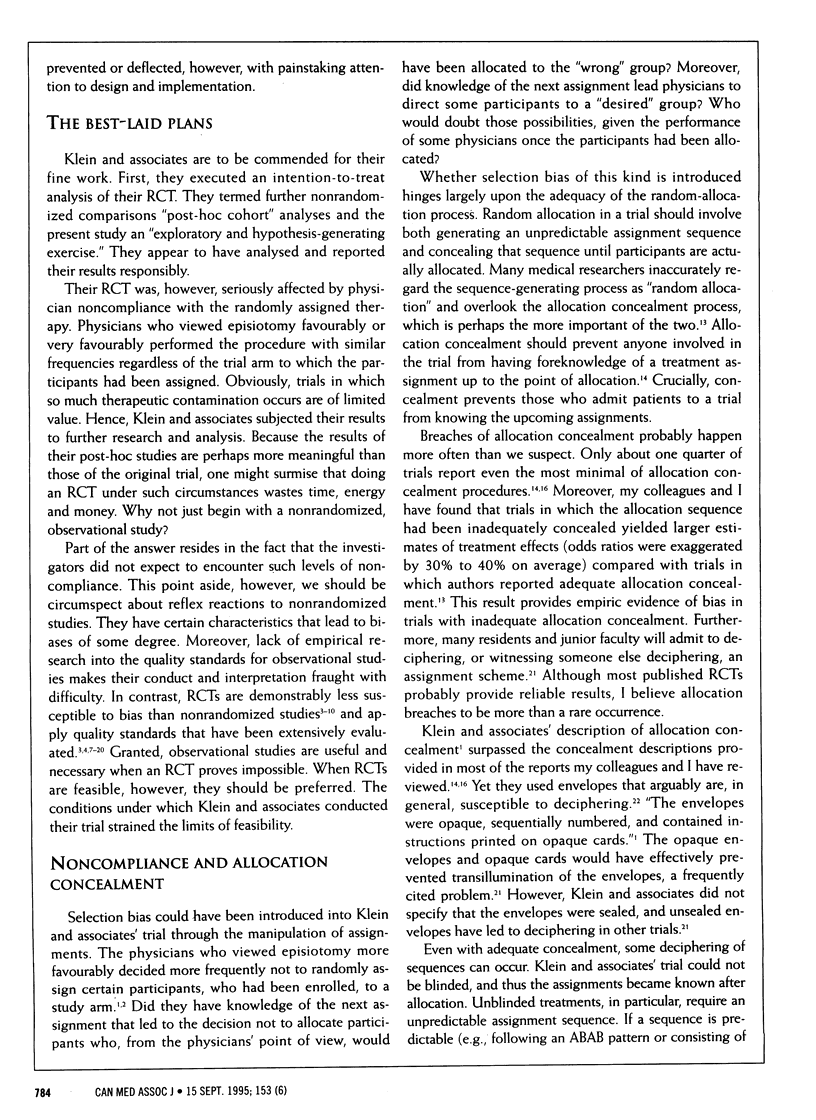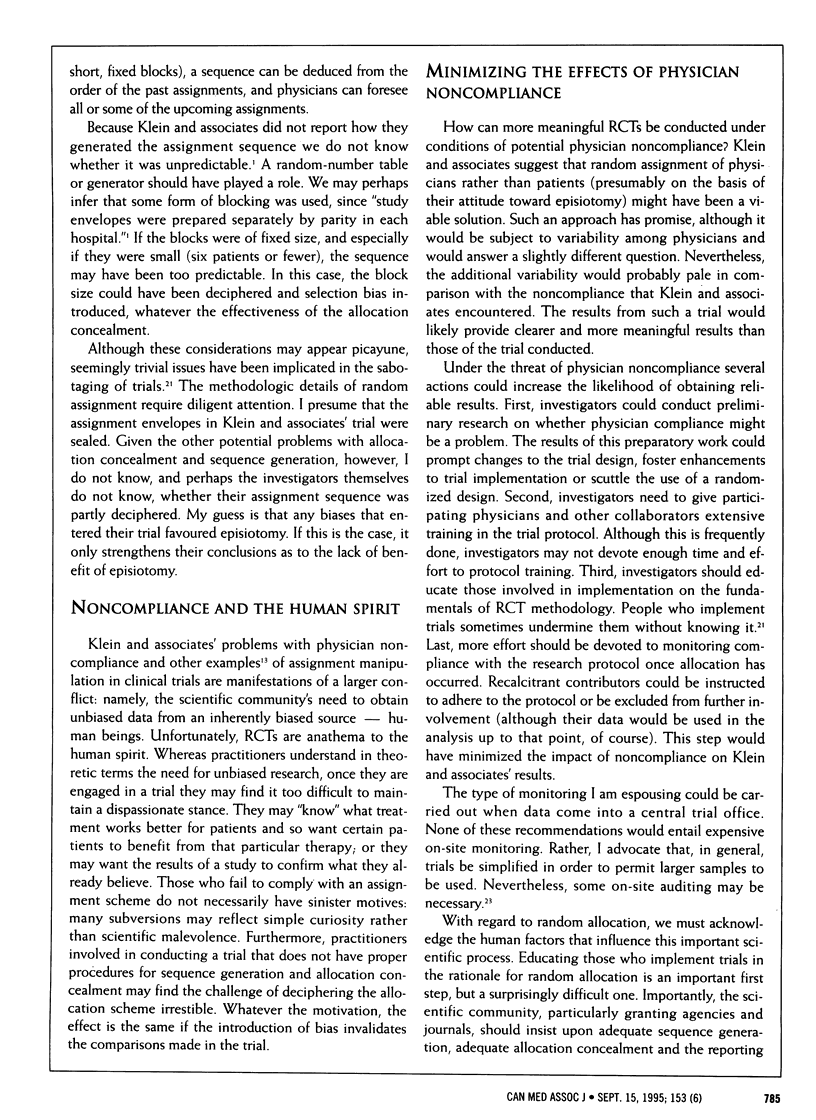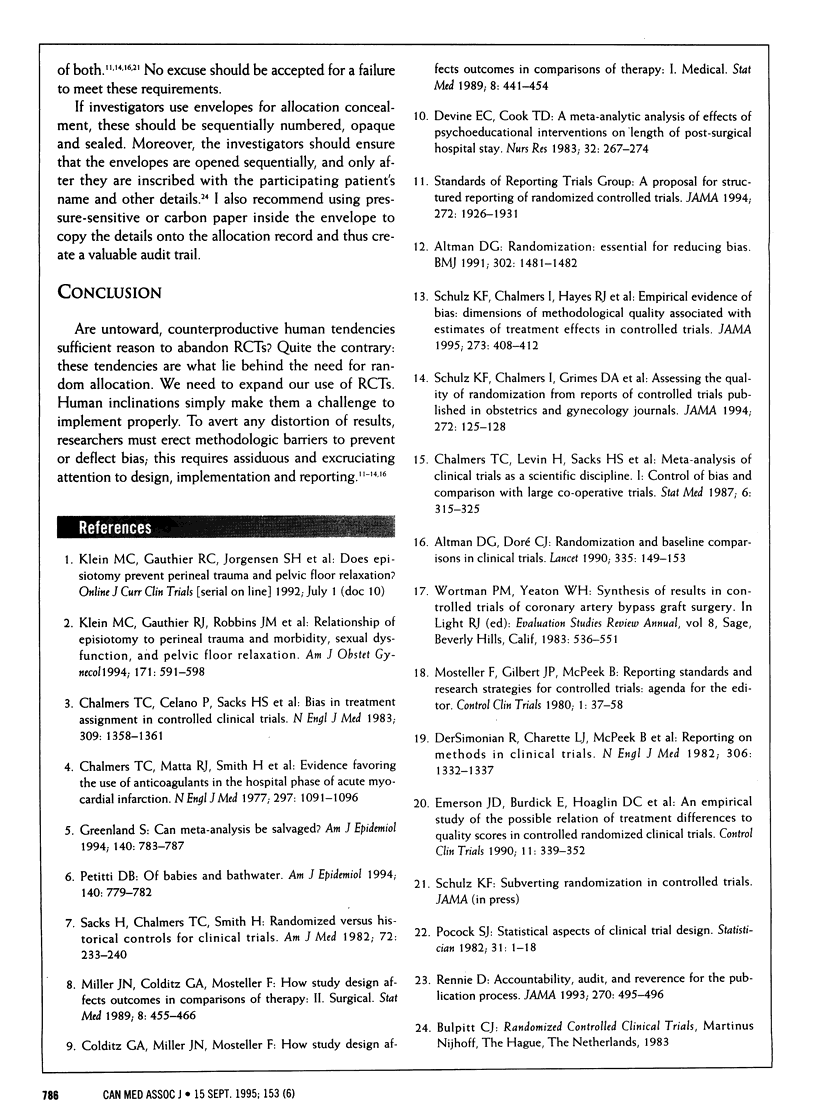Abstract
Research by Klein and associates provides useful information on the relation between episiotomy and outcomes such as perineal trauma, but the methodologic implications of their work are especially fascinating. Physicians who participated in their randomized controlled trial (RCT) were supposed to adhere to a policy of either liberal or restrictive use of episiotomy according to the study arm to which each patient was assigned. However, some used the procedure for approximately 90% of patients regardless of allocation. Klein and associates' post-hoc study (see pages 769 to 779 of this issue) sheds light on the relation between physician attitudes and the practice of episiotomy. The author contends that the noncompliance encountered by Klein and associates reflects the fact that randomized trials are anathema to the human spirit. He offers suggestions for making RCTs more meaningful and stresses that, although RCTs are indispensible to the advancement of medical knowledge, they necessitate assiduous attention to matters of design and implementation.
Full text
PDF



Selected References
These references are in PubMed. This may not be the complete list of references from this article.
- Altman D. G., Doré C. J. Randomisation and baseline comparisons in clinical trials. Lancet. 1990 Jan 20;335(8682):149–153. doi: 10.1016/0140-6736(90)90014-v. [DOI] [PubMed] [Google Scholar]
- Altman D. G. Randomisation. BMJ. 1991 Jun 22;302(6791):1481–1482. doi: 10.1136/bmj.302.6791.1481. [DOI] [PMC free article] [PubMed] [Google Scholar]
- Chalmers T. C., Celano P., Sacks H. S., Smith H., Jr Bias in treatment assignment in controlled clinical trials. N Engl J Med. 1983 Dec 1;309(22):1358–1361. doi: 10.1056/NEJM198312013092204. [DOI] [PubMed] [Google Scholar]
- Chalmers T. C., Levin H., Sacks H. S., Reitman D., Berrier J., Nagalingam R. Meta-analysis of clinical trials as a scientific discipline. I: Control of bias and comparison with large co-operative trials. Stat Med. 1987 Apr-May;6(3):315–328. doi: 10.1002/sim.4780060320. [DOI] [PubMed] [Google Scholar]
- Chalmers T. C., Matta R. J., Smith H., Jr, Kunzler A. M. Evidence favoring the use of anticoagulants in the hospital phase of acute myocardial infarction. N Engl J Med. 1977 Nov 17;297(20):1091–1096. doi: 10.1056/NEJM197711172972004. [DOI] [PubMed] [Google Scholar]
- DerSimonian R., Charette L. J., McPeek B., Mosteller F. Reporting on methods in clinical trials. N Engl J Med. 1982 Jun 3;306(22):1332–1337. doi: 10.1056/NEJM198206033062204. [DOI] [PubMed] [Google Scholar]
- Devine E. C., Cook T. D. A meta-analytic analysis of effects of psychoeducational interventions on length of postsurgical hospital stay. Nurs Res. 1983 Sep-Oct;32(5):267–274. [PubMed] [Google Scholar]
- Emerson J. D., Burdick E., Hoaglin D. C., Mosteller F., Chalmers T. C. An empirical study of the possible relation of treatment differences to quality scores in controlled randomized clinical trials. Control Clin Trials. 1990 Oct;11(5):339–352. doi: 10.1016/0197-2456(90)90175-2. [DOI] [PubMed] [Google Scholar]
- Greenland S. Can meta-analysis be salvaged? Am J Epidemiol. 1994 Nov 1;140(9):783–787. doi: 10.1093/oxfordjournals.aje.a117326. [DOI] [PubMed] [Google Scholar]
- Klein M. C., Gauthier R. J., Robbins J. M., Kaczorowski J., Jorgensen S. H., Franco E. D., Johnson B., Waghorn K., Gelfand M. M., Guralnick M. S. Relationship of episiotomy to perineal trauma and morbidity, sexual dysfunction, and pelvic floor relaxation. Am J Obstet Gynecol. 1994 Sep;171(3):591–598. doi: 10.1016/0002-9378(94)90070-1. [DOI] [PubMed] [Google Scholar]
- Miller J. N., Colditz G. A., Mosteller F. How study design affects outcomes in comparisons of therapy. II: Surgical. Stat Med. 1989 Apr;8(4):455–466. doi: 10.1002/sim.4780080409. [DOI] [PubMed] [Google Scholar]
- Petitti D. B. Of babies and bathwater. Am J Epidemiol. 1994 Nov 1;140(9):779–782. doi: 10.1093/oxfordjournals.aje.a117325. [DOI] [PubMed] [Google Scholar]
- Rennie D. Accountability, audit, and reverence for the publication process. JAMA. 1993 Jul 28;270(4):495–496. [PubMed] [Google Scholar]
- Sacks H., Chalmers T. C., Smith H., Jr Randomized versus historical controls for clinical trials. Am J Med. 1982 Feb;72(2):233–240. doi: 10.1016/0002-9343(82)90815-4. [DOI] [PubMed] [Google Scholar]
- Schulz K. F., Chalmers I., Grimes D. A., Altman D. G. Assessing the quality of randomization from reports of controlled trials published in obstetrics and gynecology journals. JAMA. 1994 Jul 13;272(2):125–128. [PubMed] [Google Scholar]
- Schulz K. F., Chalmers I., Hayes R. J., Altman D. G. Empirical evidence of bias. Dimensions of methodological quality associated with estimates of treatment effects in controlled trials. JAMA. 1995 Feb 1;273(5):408–412. doi: 10.1001/jama.273.5.408. [DOI] [PubMed] [Google Scholar]


